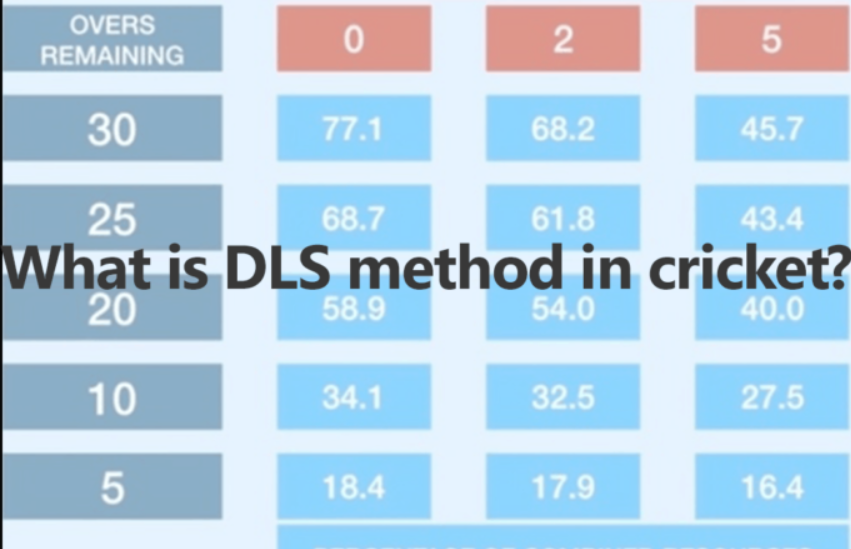DLS method in Cricket
What is DLS?
DLS method in Cricket: The DLS is a mathematical method designed to calculate the target score for the team batting second. It calculates the target in limited overs cricket matches interrupted by weather or other circumstances.
Who Invented the DLS method?
The Duckworth Lewis Method was invented by famous statisticians Frank Duckworth and Tony Lewis. Thus the method is popular as the Duckworth Lewis method. Later Professor Steven Stern became the custodian of the method. In November 2014, the Duckworth–Lewis method was then renamed the Duckworth-Lewis-Stern method.
Why is the DLS method needed?
When a match is interrupted by unforeseen inclement weather, an outcome is reached after the resumption of play. A calculation adjusts a target score according to the reduction in overs. The ICC arrives at a formula that takes into account as many parameters as possible. The data received properly reflects the efforts of both teams. The DLS method is considered the most accurate system used in international cricket.
Reason to follow the DLS method
The attraction toward cricket keeps increasing among the masses. It is widely played and followed in almost every country. Cricket is recognized as the most popular sport in the world after Football and Rugby.
Cricket has been played in two sessions. In the first session, a team goes on to bat in pairs against the bowling team. The same follows vice versa in the second session.
The enjoyment of the game is ruined when the rain interrupts the match. In such conditions, the DLS Method is applied to restore the game.
Difference – Par Score and Target Score
Par score – The total that a chasing team should have reached when they are ‘X’ wickets down at the time of interruption.
Target score – The revised score that a team is required to get according to the number of wickets lost after an interruption.
How does DLS work?
The DLS or the Duckworth-Lewis-Stern method works on the principle that a batting team has two resources in hand when starting ODI innings. These are 300 deliveries and ten wickets. As the innings go on, these resources keep depleting. Eventually, the resources reach zero. A team either plays out all 300 deliveries or is at a loss of all 10 wickets.
When the batting team loses overs, they get no opportunity to make full use of their resources. Targets revised are proportional to the number of resources available to each team.
The rate at which the mentioned resources deplete is not uniform across the overs. It varies depending on the scoring patterns of ODIs in history. At any point, the resources lost due to an interruption mainly depend on:
– number of overs that are lost
– stage of an innings of the match when the overs are lost
– wickets in hand at the time of the interruption due to weather or any other circumstances
Losing overs in the later stages of an innings impacts a team more than losing the same number of overs earlier in an innings. Those overs are productive in nature. The teams have less opportunity to recalibrate their targets if the overs are lost early in the innings.
A team that is six down after 20 overs will have less chance to lose from a 10-over interruption. The team that is two down at that stage will have more chance to lose. The reason in the first case is that the team has already lost a huge chunk of their batting resources for six wickets. A team that is only two wickets down can better capitalize on the last 30 overs. The team that is six down may not.
DLS Method Calculation
To calculate a target score, the formula is simply expressed as:
TEAM 2 PAR SCORE = TEAM 1 SCORE X
(TEAM 2 RESOURCES/TEAM 1 RESOURCES)
Examples
Stoppage in 1st innings
Increased target:
4th India-England ODI – 2008 series – 22 overs – India (batting first) made 166/4 – Target score for England – 198 – England score – 178/8 – India won by 19 runs – DLS method.
Decreased Target:
Sri Lanka-England ODI – 3 December 201 – 35 overs – Sri Lanka scored 242/8 – Target score for England 236/8.
Stoppage in 2nd Innings
India-Pakistan ODI – 2006 series – India batted first and were all out at 328 runs – Pakistan scored 311/7 when there was an interruption at the 47th over – The target score was set at 305 – Pakistan won by 7 runs – DLS method.
Stoppage in both 1st and 2nd Innings
2012/2013 KFC Big Bash League – Melbourne Stars and Perth Scorchers – Melbourne Stars at 159/1 off 15.2 overs – both innings reduced by 2 overs – MS finished at 183/2 – Perth innings reduced to 17 overs due to rain – Revised target for Perth – 139 – Perth won by 8 wickets.

